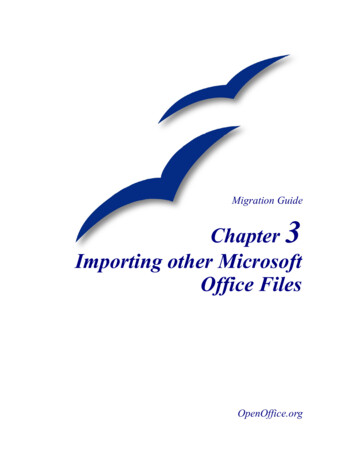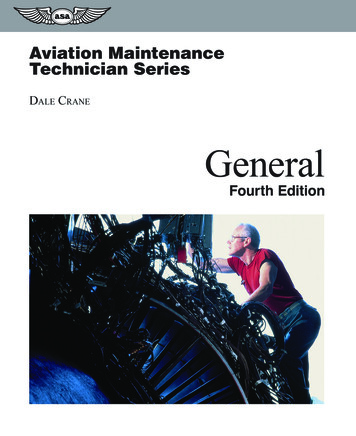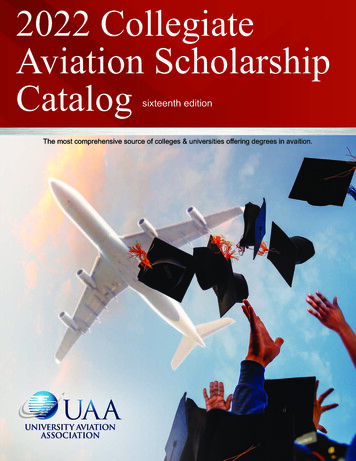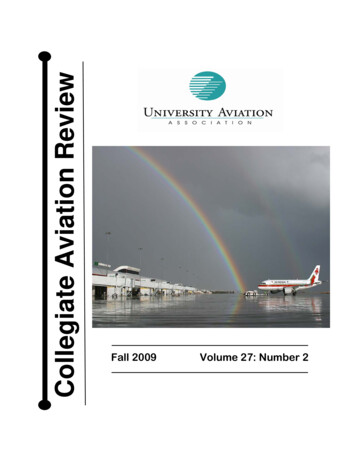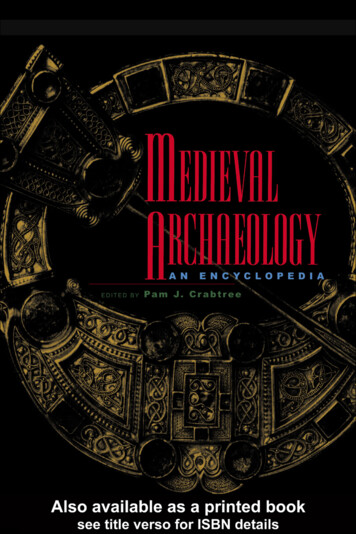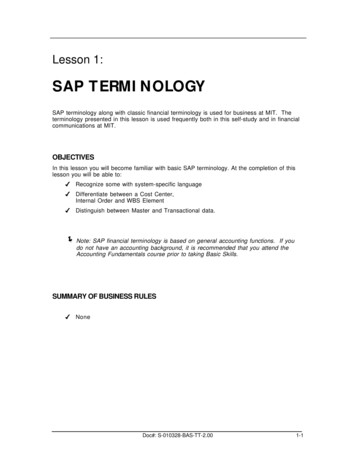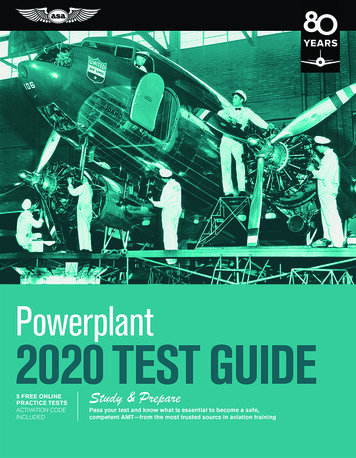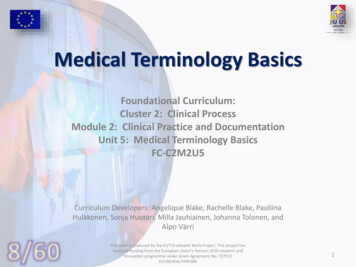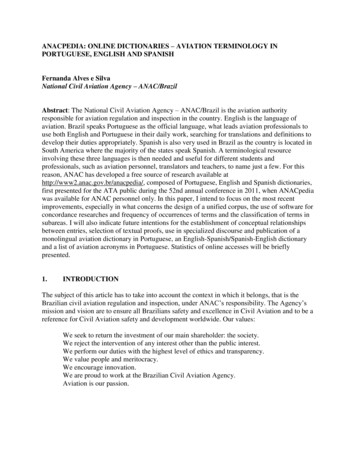
Transcription
ANACPEDIA: ONLINE DICTIONARIES – AVIATION TERMINOLOGY INPORTUGUESE, ENGLISH AND SPANISHFernanda Alves e SilvaNational Civil Aviation Agency – ANAC/BrazilAbstract: The National Civil Aviation Agency – ANAC/Brazil is the aviation authorityresponsible for aviation regulation and inspection in the country. English is the language ofaviation. Brazil speaks Portuguese as the official language, what leads aviation professionals touse both English and Portuguese in their daily work, searching for translations and definitions todevelop their duties appropriately. Spanish is also very used in Brazil as the country is located inSouth America where the majority of the states speak Spanish. A terminological resourceinvolving these three languages is then needed and useful for different students andprofessionals, such as aviation personnel, translators and teachers, to name just a few. For thisreason, ANAC has developed a free source of research available athttp://www2.anac.gov.br/anacpedia/, composed of Portuguese, English and Spanish dictionaries,first presented for the ATA public during the 52nd annual conference in 2011, when ANACpediawas available for ANAC personnel only. In this paper, I intend to focus on the most recentimprovements, especially in what concerns the design of a unified corpus, the use of software forconcordance researches and frequency of occurrences of terms and the classification of terms insubareas. I will also indicate future intentions for the establishment of conceptual relationshipsbetween entries, selection of textual proofs, use in specialized discourse and publication of amonolingual aviation dictionary in Portuguese, an English-Spanish/Spanish-English dictionaryand a list of aviation acronyms in Portuguese. Statistics of online accesses will be brieflypresented.1.INTRODUCTIONThe subject of this article has to take into account the context in which it belongs, that is theBrazilian civil aviation regulation and inspection, under ANAC’s responsibility. The Agency’smission and vision are to ensure all Brazilians safety and excellence in Civil Aviation and to be areference for Civil Aviation safety and development worldwide. Our values:We seek to return the investment of our main shareholder: the society.We reject the intervention of any interest other than the public interest.We perform our duties with the highest level of ethics and transparency.We value people and meritocracy.We encourage innovation.We are proud to work at the Brazilian Civil Aviation Agency.Aviation is our passion.
ANAC deals with a variety of areas within aviation, the principal ones being AirportInfrastructure, Operations, Air Services, Economic Regulation of Airports, Airworthiness andInternational Relations.The Linguistics Office of the Training Branch, under the Department of People Management, isresponsible for ANACpedia and it develops other activities involving languages as well, such asaviation English courses and evaluations of proficiency in Spanish and English.The Linguistics Office was presented with the challenge of developing a free, online terminologyresource, which could offer aviation terms and acronyms with equivalents in other languages,definitions, synonyms and other linguistic information considering the needs of a variety ofdifferent users within the aviation area and, statistics proved later on, from outside the aviationworld.In this paper, I will focus on the most recent improvements developed by the staff in consonancewith the needs of ANACpedia users and on the enrichment of information available with the useof a software for automatic extraction of linguistic and terminological data. Statistics of accessesthrough the Internet will be briefly presented, especially with emphasis on the variety of usersfrom different regions of the world. In addition, I will present future intentions such as thepublication of monolingual and bilingual dictionaries and a list of acronyms in Portuguese.2.BACKGROUND2.1 ANACpedia in 2011ANACpedia was available on the Intranet of the Agency in 2011 and on the Internet in 2013.During the 52nd American Translators Association Annual Conference, in Boston, 2011,ANACpedia was presented and I talked about the staff involved, motivation, methodology ofwork, linguistic information researched, intended technical cooperation agreements, dictionariesand number of entries.Staff was composed of language professionals and librarians. The main motivations in thebeginning were to standardize translations of aviation terms from English and Spanish intoPortuguese, for use in daily translation activities, and to standardize definitions. Relationsbetween terms, presence of contexts of use and the use of tools for carrying out corpus linguisticsresearch, for example, were not the focus. Information available at the time involved equivalentterms in Portuguese, definitions and bibliographical sources. Arrangements for a technicalcooperation agreement with a Brazilian university were initiated, but not concluded. Dictionariesand entries available in 2011: English-Portuguese/Portuguese-English: 1900 terms; SpanishPortuguese/Portuguese-Spanish: 1700 terms; Acronyms in English: 2370.3.ANACPEDIA IN 2015
ANACpedia has been available on the Internet since 2013. The staff managing the dictionariestoday is also composed of a language professional and a librarian, counting with three traineeswho study Languages and/or Translation at the university. Although chiefs of sectors withinANAC have tried to expand the team, no professionals in the area of languages, linguistics ortranslation were hired.A partnership with the Brazilian Department of Airspace Control started in 2014. A great part ofrecent researches and improvements has been developed due to the work performed by ANACand DECEA in partnership.The difference regarding the method of researching terms, acronyms, definitions, equivalents andother relevant information if we compare studies developed in 2011 and researches developednowadays is that we have structured a corpus for each language involved – Portuguese, Englishand Spanish – and have been using them through a software for automatic extraction ofinformation.We can say that we have been using a methodology subsidized by corpus linguistic researchemphasizing the search for relations between terms, between acronyms and between terms andacronyms, proofs of use and classification of entries in subareas of the major aviation area.The group is prioritizing researches for enrichment of dictionaries and list of acronyms availablein place of increases in the numbers of entries. Currently, the English-Portuguese/PortugueseEnglish dictionary has around 4000 entries; the list of aviation acronyms in English has around4000 acronyms; and the Spanish-Portuguese/Portuguese-Spanish dictionary has around 2000entries.New dictionaries and a list of acronyms are also under development and the staff intends topublish them this year: an English-Spanish/Spanish-English dictionary containing around 740terms; a Portuguese dictionary with around 2900 terms; and a list of aviation acronyms inPortuguese with around 380 entries.4.TECHNICAL COOPERATION AGREEMENT – DETAILSIn November 2013, the team was contacted by two Translators of the Brazilian Department ofAirspace Control who were highly interested in working together with the group for providingterminological data related to air space control, area in which they are specialists. DECEATranslators informed that similar initiatives were started within the Department, but interrupteddue to a variety of factors.Professionals from ANAC and DECEA noticed that a partnership for developing terminologicalresearches and products would be very appropriate and useful. This way, the now called ANACDECEA working group for ANACpedia has started to meet on a regular basis since February2014 and the parties intend to sign an official Technical Cooperation Agreement.
The aforementioned working group has been participating in very productive weekly meetingsduring which professionals review terminological data available, research related (RT) and newterms, discuss about technical matters as to solve doubts or to send them to specialists forresolution and elaborate and discuss about adequate classification of terms in subareas, amongother things. All the information researched during meetings is gathered and recorded interminological records for future inclusion in ANACpedia products by ANAC.5.TERMINOLOGICAL RECORDSANAC-DECEA working group for ANACpedia structures the results of the weekly work indocuments in Word format called terminological records. They aim at recording informationdiscussed and validated during the meetings (or data to be researched in the future) in order to beincluded in ANACpedia by ANAC personnel, who control the software for terminologymanagement.Terminological records are precious sources of information as background on the discussions,validations and doubts are registered. They are preferably structured in accordance with the orderin which information will be included in ANACpedia, considering the possibilities offered by theterminology management software used by the team.6.CORPUSANACpedia team has structured three corpora, one for each language involved: Portuguese,English and Spanish, composed by at around 27 million words. It is important to mention that,especially for the English language, a great number of sources available on the market, such asaviation dictionaries, glossaries, lists of terms and lists of acronyms have been used, but are notincluded in the electronic English corpus for obvious reasons.ANACpedia corpora is composed of a great variety of sources of research, in specialpublications of: the Brazilian civil aviation authority (ANAC); the Brazilian aeronauticalauthority; the International Civil Aviation Organization – ICAO (a specialized United NationsAgency for aviation); international aviation authorities (FAA, JAA, EUROCONTROL,JEPPESEN, Aviation Authority of Australia etc.); and the aeronautical products industry.Technical documents used in daily activities, the Internet and interactions with specialists havebeen largely used as sources of information.ANAC and airspace control publications are available on the Internet, sp and http://publicacoes.decea.gov.br/, with theexception of publications classified as restricted.7.SUBAREAS
Subareas can be briefly defined as specific areas hierarchically subordinated to a major area,which, in our case, is aviation. Subareas have been researched, defined, listed, and included inANACpedia so we can classify terms and acronyms according to their frequency in the contextsof use. The classification of entries in subareas of aviation enrich the dictionaries considerablyand improves the quality of results for users, helping them to understand definitions and conceptsbetter.Subareas were not always present in ANACpedia. Although we had a kind of internalclassification since the beginning, we had not made subareas available for users until 2014, as itis a very hard task to determine and define subareas for entry classification, especiallyconsidering aviation as a complex field. The team found that, although this is a very complexwork, it was necessary to consolidate some subareas even to help the team to take decisionsabout synonyms and contexts, for example. An entry may have different meanings according tothe subareas where they may occur. The statement of Bononno (2000, page 651) supported thedecision taken by the group: “Conventional technical dictionaries, at least the better ones, oftenprovide labels to indicate the field of application or domain for a headword.”For a better development of our research, we have developed a list of subareas and a definitionfor each of them. We understand that a definition for each subarea included and prepared basedon dictionaries and other sources, helps the work of classification of terms and acronyms.8.CORPUS LINGUISTICS RESEARCHSince the first use of AntConc software (Concordance), it was possible to identify how usefulresults the software would offer. It was noticed that immediate results would open up newpossibilities for researches on related, narrow (NT) and broader terms (BT), proofs of use andsubareas, to name just a few.In this item, I will detail two examples: one showing the improvements on a term resulting fromthe use of AntConc; and a term researched with the use of the automatic extraction tool since thebeginning. Terms used as examples in English and Portuguese are aerodrome/aeródromo andcockpit voice recorder (CVR)/gravador de voz na cabine de comando.8.1 Aerodrome/aeródromoThe term aerodrome is presented in the English-Portuguese dictionary with the followinginformation: definition, source, two additional notes, subarea and the equivalent term inPortuguese – aeródromo, as can be seen below.
Picture 1 – aerodromeConsidering aerodrome a term widely used in aviation, we can affirm that there is a variety ofrelated terms linked to aerodrome, which are not listed in the term record available for users, as asoftware for automatic research was not used at the time. Neither related terms nor proofs of usein real contexts, broader terms or narrow terms, for example, were available.If we look at picture 2, which shows part of the research using AntConc (Concordance), wenotice that the software offers a list of related and narrow terms for aerodrome, and thisconsidering only a small part of the results.
Picture 2 – AntConc (Concordance) results for aerodrome (RT, NT)Picture 3 below shows proofs of use of the term aerodrome, in real contexts, offered by AntCon(Concordance).Picture 3 – AntConc (Concordance) results for aerodrome (proofs of use)
For aeródromo, equivalent in Portuguese for aerodrome, conclusions are the same. The originalresearch indicated a definition, a source, three additional notes, a subarea and the equivalent termin English (aerodrome). However, neither related terms nor proofs of use in real contexts,broader terms or narrow terms, for example, were available. If we consider aeródromo one of themost used terms in aviation, the lack of information aforementioned does not enrich dataavailable for users. The next picture shows aeródromo available for users before the use of anautomatic tool for linguistic research.Picture 4 – aeródromoThe following illustration shows the possibilities of related terms and narrow terms offered byAntConc (Concordance) for aeródromo.
Picture 5 – AntConc (Concordance) results for aeródromo (RT, NT)Picture 6 below shows proofs of use of the term aeródromo, in real contexts, offered by AntCon(Concordance).Picture 6 – AntConc (Concordance) results for aeródromo (proofs of use)
8.2 Cockpit voice recorder (CVR)/gravador de voz na cabine de comandoCockpit voice recorder (CVR) was researched in the English and Portuguese corpora forinclusion in ANACpedia and so the automatic research made it possible the gathering ofimportant terminological information: definition, sources, two additional notes, proof of use,subarea, related term and the equivalent in Portuguese – gravador de voz na cabine de comando,as below.Picture 7 – AntConc (Concordance) results for cockpit voice recorder (CVR)The term flight data recorder was found as related to cockpit voice recorder (CVR) in thecorpora, and so the staff proceeded to researches on the RT.
Picture 8 – AntConc (Concordance) results for flight data recorder (RT)When searching for information about the RT flight data recorder, we found two synonyms:black box and data recorder, which originated the information shown in the next two pictures.Picture 9 – AntConc (Concordance) synonym for RT flight data recorder
Picture 10 – AntConc (Concordance) synonym for RT flight data recorderFor gravador de dados de voo, equivalent in Portuguese for cockpit voice recorder (CVR), therichness of information resulting from the search using AntConc (Concordance) can be listed aswell: synonym, definitions, sources, subarea and related term.Picture 11 – AntConc (Concordance) results for gravador de dados de voo
The same way that happened during researches on cockpit voice recorder (CVR), the termgravador de voz na cabine de comando was presented in the Portuguese corpus as RT ofgravador de dados de voo, this way leading to another semantic relation, improving informationavailable.Picture 12 – AntConc (Concordance) results for gravador de voz na cabine de comando (RT)It can be concluded that researches with the use of a software for automatic extraction of dataproved to be richer, more efficient and effective, as they do not only provide informationpromptly, but also lead the researcher to establish linguistic and semantic relations betweenterms, between acronyms and between terms and acronyms. The mentioned relations improvethe quality of the terminological product in consonance with its main objective: to offer users themost comprehensible information as possible.9.STATISTICSSince January 2014, statistics of accesses have been monitored as we aim at verifying accessrates in different periods. In addition, we would like to know the origin of accesses, that is, fromwhich countries users have been accessing ANACpedia. Other specifications such asgeographical regions in Brazil and Internet browsers used may also be monitored.Based on the statistics available, we are positively surprised as the number of accesses surpassedthe expected. The variety of countries accessing the dictionaries and list of acronyms was also agood surprise as it corroborates that ANACpedia is an useful tool for a varied audience,especially aviation professionals and translators in many countries, not only in Brazil.
Picture 13 shows the total number of accesses (13.752) from April 29 to August 12, 2015, accessper page and time spent on each specific web link.Picture 13 – number of accesses from April 29 to August 12, 2015The next pictures show part of the Google Analytics statistical search for countries that accessedANACpedia from March to April 2015. It is important to mention that in only one month, usersfrom twenty different countries accessed the dictionaries and list of acronyms.
Picture 14 – countries that accessed ANACpedia from March to April 2015Picture 15 – countries that accessed ANACpedia from March to April 2015
10.FINAL REMARKSANACpedia allows endless possibilities for the development of actions, activities, works, newdictionaries and databases, ontologies, classification systems, domain trees, etc., not to mentionacademic studies on the project.Therefore, given the numerous possibilities, it is important to plan actions in order to setpriorities, while considering results in the medium and long term.As next steps, the team intends to develop a monolingual dictionary in Portuguese, a list ofaviation acronyms in Portuguese, and two bilingual dictionaries: an English-Spanish/SpanishEnglish and a French-Portuguese/Portuguese-French dictionary. In addition, continuous reviewand improvement of dictionaries and list of acronyms available is constant in our daily activitiesfor quality assurance. The celebration of Technical Cooperation Agreements is also desired.11.REFERENCES1. ANAC’s Training Web Page https://sistemas.anac.gov.br/capacitacao/ in August 6th, 2013.2. ANAC’s Web Page start.htm?sid 330 inAugust 5th, 2013.3. ANTHONY, Laurence. AntConc (Windows, Macintosh OS X, and Linux): build 3.4.3.Tokyo: Waseda University, september, 17th, 2014. Available /releases/AntConc343/help.pdfAcess on: July 24th, 2015.4. BONONNO, R. Terminology for translators: an implementation of ISO 12620. Meta, XLV, 4,2000.5. BRASIL. Agência Nacional de Aviação Civil. ANACpédia. Available in: http://www2.anac.gov.br/anacpedia .
ANACPEDIA: ONLINE DICTIONARIES - AVIATION TERMINOLOGY IN PORTUGUESE, ENGLISH AND SPANISH Fernanda Alves e Silva National Civil Aviation Agency - ANAC/Brazil Abstract: The National Civil Aviation Agency - ANAC/Brazil is the aviation authority responsible for aviation regulation and inspection in the country.
